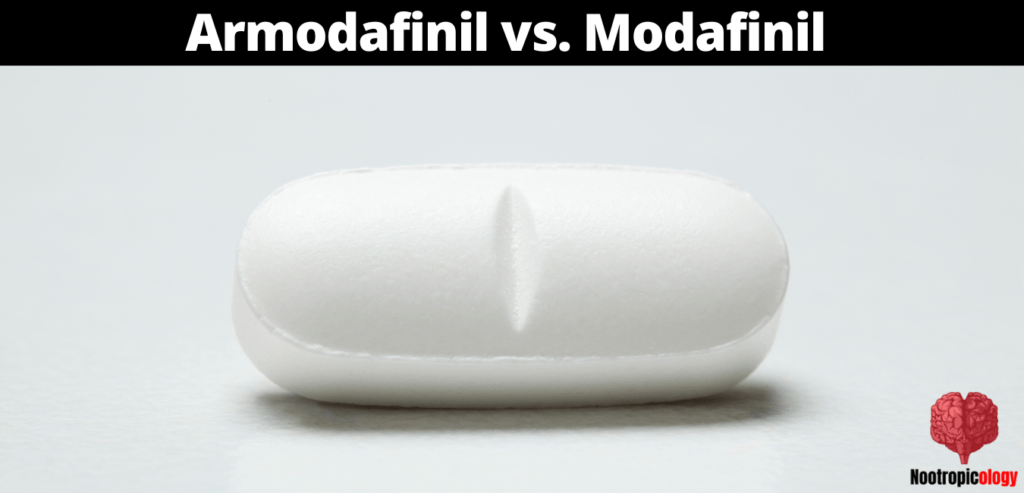Armodafinil vs Modafinil: Which Is the Best Option for Boosting Your Alertness?
The ability to stay alert and focused is an essential part of our lives in this modern society.
For some, staying awake and engaged in tasks can be a struggle, so drugs like Armodafinil and Modafinil are increasingly used as cognitive enhancers to promote wakefulness and improve productivity.
In this article, I'll take a closer look at the differences between Armodafinil and Modafinil to help you determine which one is the best option for boosting your alertness.
So without further ado, let's dive, shall we?
About Modafinil and Armodafinil


Modafinil (Provigil) and Armodafinil (Nuvigil) are two pharmaceuticals that have gathered much attention in the past years due to their capability to enhance brain function.
They are FDA-approved treatments for narcolepsy, sleep apnea, and shift work sleep disorder. They are also commonly used off-label as cognitive enhancers. They may be prescribed to individuals with attention deficit hyperactivity disorder (ADHD), depression, and cognitive impairment due to aging or neurological injury.
They both belong to a class of drugs known as “eugeroics,” which are drugs that promote wakefulness and alertness by stimulating the central nervous system (CNS).
What is Modafinil?
Modafinil is a prescription medication that promotes wakefulness and alertness. It is classified as a Schedule IV controlled substance in the U.S. and is available by prescription only.
It is a racemic compound consisting of two enantiomers called R-modafinil and S-modafinil. The S-enantiomer is believed to be pharmacologically inactive, while the R-enantiomer is responsible for most of the pharmacological effects of Modafinil.
Modafinil works by acting on several neurotransmitters, such as dopamine and norepinephrine, which are involved in regulating sleep and wakefulness. It also affects histamine, which affects wakefulness and regulates immune function.
It is approved by the U.S. Food and Drug Administration (FDA) for the treatment of narcolepsy, sleep apnea, shift work sleep disorder, and idiopathic hypersomnia. It is sometimes used off-label to improve cognitive function and mental performance in healthy individuals or to treat depression.
Several studies have shown that Modafinil can improve healthy individuals' cognitive function and mental performance when taken in low doses.[1]
However, more research is needed to establish Modafinil's long-term safety and efficacy in healthy individuals. Some controversies have arisen about using Modafinil as a cognitive enhancer, particularly in academic and professional settings.
Modafinil is usually taken at doses between 100-200mg. It has a half-life of about 15 hours, so it should be taken in the morning to minimize any potential interference with sleep.
What is Armodafinil?
Armodafinil is a prescription medication that promotes wakefulness and alertness. It is a purified form of Modafinil that contains only the R-enantiomer. This means that it has a different chemical composition than Modafinil and has a different rate of absorption and elimination.[2]
Like Modafinil, it is known to be a central nervous system stimulant, which means that it stimulates the brain functions that help regulate sleep and wake cycles.
Armodafinil is believed to act on several neurotransmitters, including dopamine and norepinephrine, which play a role in maintaining wakefulness and alertness.
it is approved by the U.S. Food and Drug Administration (FDA) for the treatment of narcolepsy, obstructive sleep apnea, and shift work sleep disorder. It has also been used off-label to improve cognitive function and mental performance in healthy individuals or to treat depression.
Armodafinil is usually taken orally as a tablet or capsule. The recommended initial dose is 150 mg once a day. The dose can be increased to 200 mg per day, but it is not recommended to exceed this dose.
Benefits of Modafinil vs. Armodafinil
There are some differences between the two drugs that may make one more suitable for certain individuals. Let's take a look at some of the benefits of Modafinil vs. Armodafinil below.
Modafinil Benefits
Modafinil is a racemic compound, meaning that it contains two distinct enantiomers, R-modafinil and S-modafinil. One of the benefits of modafinil is that it has a long duration of action, lasting up to 12-15 hours. This makes it a good option for people who need to stay alert and focused for an extended period of time.
Another benefit of Modafinil is that it has been shown to be effective in improving the quality of life in patients with narcolepsy, sleep apnea, and other sleep disorders. Research has demonstrated that Modafinil can bolster cognitive capabilities in healthy adults and lessen depressive symptoms for individuals with depression, thereby leading to higher performance and productivity.[3]
Armodafinil Benefits
On the other hand, Armodafinil is the R-enantiomer of Modafinil and is considered more potent. One of the benefits of Armodafinil is that it requires a lower dosage compared to Modafinil to achieve the same effect, ranging from 50-150 mg/day.
Armodafinil has also been shown to be well-tolerated by patients with sleep disorders. Another potential benefit of Armodafinil is that it has a relatively low potential for abuse and dependence compared to other stimulants like amphetamines or methylphenidate.
A comprehensive study into the benefits of Armodafinil as a treatment for narcolepsy patients revealed that it significantly improves wakefulness throughout the day. Additionally, this medication was shown to improve overall clinical condition, memory, attention, and fatigue when compared with its placebo equivalent.[4]
This robust research attests to Armodafinil's efficacy in treating excessive sleepiness associated with narcolepsy.
Side Effects of Armodafinil vs Modafinil
While both drugs have similar mechanisms of action, there are some notable differences in their side effects.
Modafinil Side Effects
Modafinil's most common side effects include headaches, nervousness, nausea, insomnia, dry mouth, and dizziness. These symptoms may occur in up to 10% of patients taking Modafinil and are usually mild to moderate in severity.
Other potential but less common side effects of Modafinil include anxiety, agitation, irritability, and loss of appetite. These side effects can occur in up to 5% of patients taking the medication and may be more severe in those with underlying psychiatric or anxiety disorders.
In rare cases, Modafinil can cause serious side effects such as Stevens-Johnson syndrome (a severe allergic reaction) or anaphylaxis (a potentially life-threatening allergic reaction). Patients should seek medical attention immediately if they experience any signs or symptoms of either condition.[5]
To reduce the risk of experiencing any side effects from taking Modafinil:
- Take the lowest possible dose that is effective for managing your symptoms.
- Avoid taking it too late in the day, as it could disrupt your sleep cycle.
- Avoid drinking alcohol or using other drugs that can cause drowsiness or interact with the medication.
- Ensure your doctor is aware of any other medications you are taking—some medications may increase your risk for side effects when taken together.
- Seek medical attention immediately if you experience any sudden onset or worsening symptoms.
Armodafinil Side Effects
A study of 743 enrolled patients examined Armodafinil's effects over 12 months or more.[6]
The study found that 57% (420/743) of patients completed the 12-month (or longer) treatment period, while 13% (95/743) discontinued due to adverse events.
Of those who remained on therapy, headache (25%, 180/731), nasopharyngitis (17%, 123/731), and insomnia (14%, 99/731) were the most common adverse events. However, these side effects were typically mild to moderate in severity and often resolved within weeks after starting treatment.
A subtle increase in vital sign measurements was seen among all patient groups—including heart rate by 6.7 beats per minute and blood pressure by 3.6/2.3 mm Hg—but did not cause any serious concern for medical professionals or pose any risk to patients taking Armodafinil.
Improvements from baseline in efficacy assessments also started at month one and were maintained throughout the trial period in all three conditions: Obstructive Sleep Apnea (OSA), Shift Work Disorder (SWD), and Narcolepsy (NPS).
According to Black, Jed E et al. Armodafinil appears to have relatively minor side effects, which typically resolve shortly after starting treatment. Vital sign measurements are unlikely to cause concern among patients taking Armodafinil.
My Opinion on Armodafinil vs Modafinil
I have used Modafinil and Armodafinil on and off for the past 8 years for nootropic purposes. I personally prefer Modafinil over Armodafinil for the simple reason that Armodafinil tends to raise my body temperature quite a bit.
Although I find that the effects of Armodafinil last a little longer than those of Modafinil, overall, I prefer the shorter duration.
In terms of side effects, both medications appear to have relatively minor side effects. However, I find that Modafinil tends to be more tolerable for me than Armodafinil due to the less intense body temperature increase and shorter duration of effects.
Armodafinil also makes me more irritable, a side effect I don't particularly enjoy.
That said, if you're already taking Modafinil and want a more potent, longer-lasting effect, Armodafinil can be a good option for you. However, I would recommend consulting your doctor before making any changes to your medication regimen.
My Final Verdict: Which is Better - Armodafinil or Modafinil?
So what is my final opinion on Armodafinil vs. Modafinil?
As mentioned, I prefer Modafinil due to its shorter duration and milder side effects. Modafinil gets me in "the zone" quickly, and I find that it helps boost my productivity without any crashes afterward.
That said, there's no doubt that Armodafinil is more potent than Modafinil, but it comes with a huge downside, for me at least, which is the significant temperature increase it causes.
Ultimately, I believe that Modafinil is a better option than Armodafinil if you're looking for something to boost your alertness and productivity. If you want to get your hands on Modafinil, you can check out online suppliers like ModafinilXL. You can find them right here:
- Cope, Zackary A et al. “Modafinil improves attentional performance in healthy, non-sleep deprived humans at doses not inducing hyperarousal across species.” Neuropharmacology vol. 125 (2017): 254-262. doi:10.1016/j.neuropharm.2017.07.031 ↑
- Garnock-Jones, Karly P et al. “Armodafinil.” CNS drugs vol. 23,9 (2009): 793-803. doi:10.2165/11203290-000000000-00000 ↑
- Kaser, Muzaffer et al. “Modafinil Improves Episodic Memory and Working Memory Cognition in Patients With Remitted Depression: A Double-Blind, Randomized, Placebo-Controlled Study.” Biological psychiatry. Cognitive neuroscience and neuroimaging vol. 2,2 (2017): 115-122. doi:10.1016/j.bpsc.2016.11.009 ↑
- Harsh, John R et al. “The efficacy and safety of armodafinil as treatment for adults with excessive sleepiness associated with narcolepsy.” Current medical research and opinion vol. 22,4 (2006): 761-74. doi:10.1185/030079906X100050 ↑
- Prince, V et al. “Stevens-Johnson syndrome induced by modafinil.” Clinical and experimental dermatology vol. 43,2 (2018): 191-192. doi:10.1111/ced.13282 ↑
- Black, Jed E et al. “The long-term tolerability and efficacy of armodafinil in patients with excessive sleepiness associated with treated obstructive sleep apnea, shift work disorder, or narcolepsy: an open-label extension study.” Journal of clinical sleep medicine : JCSM : official publication of the American Academy of Sleep Medicine vol. 6,5 (2010): 458-66. ↑
